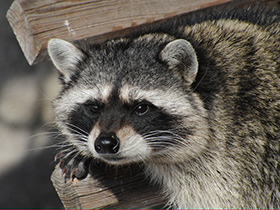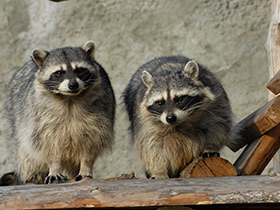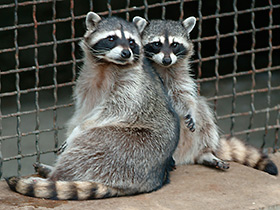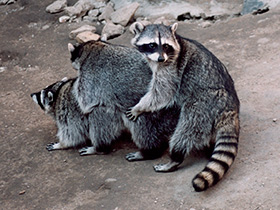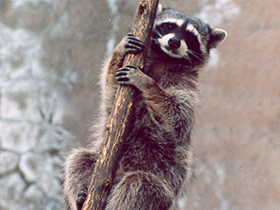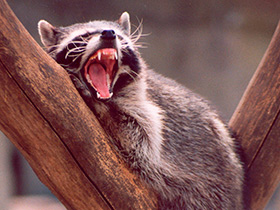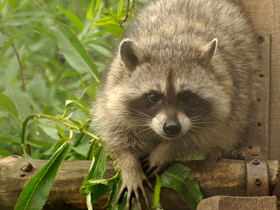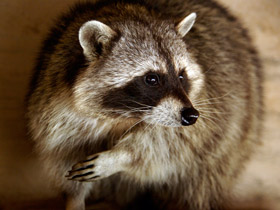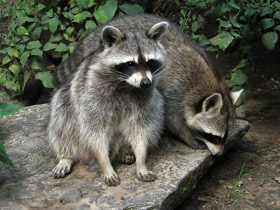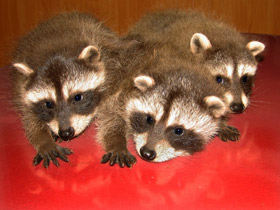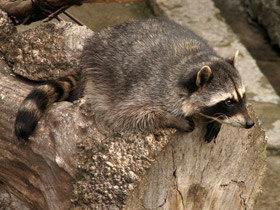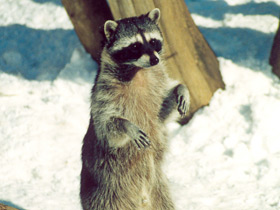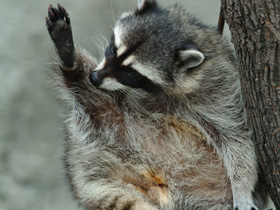Procyoninae o Procyonidae
Raccoon Procyon lotor
The raccoon (Procyon lotor), racoon and the common raccoon, the North American raccoon and northern raccoon
The raccoon (/rəˈkuːn/ or US: /ræˈkuːn/, Procyon lotor), also spelled racoon and sometimes called the common raccoon to distinguish it from other species, is a mammal native to North America. It is the largest of the procyonid family, having a body length of 40 to 70 cm (16 to 28 in), and a body weight of 5 to 26 kg (11 to 57 lb). Its grayish coat mostly consists of dense underfur, which insulates it against cold weather. Three of the raccoon's most distinctive features are its extremely dexterous front paws, its facial mask, and its ringed tail, which are themes in the mythologies of the indigenous peoples of the Americas relating to the animal. The raccoon is noted for its intelligence, as studies show that it is able to remember the solution to tasks for at least three years. It is usually nocturnal and omnivorous, eating about 40% invertebrates, 33% plants, and 27% vertebrates.
The original habitats of the raccoon are deciduous and mixed forests, but due to their adaptability, they have extended their range to mountainous areas, coastal marshes, and urban areas, where some homeowners consider them to be pests. As a result of escapes and deliberate introductions in the mid-20th century, raccoons are now also distributed across central Europe, the Caucasus, and Japan.
In Europe, the raccoon is included since 2016 in the list of Invasive Alien Species of Union concern (the Union list). This implies that this species cannot be imported, bred, transported, commercialized, or intentionally released into the environment in the whole of the European Union.
Though previously thought to be generally solitary, there is now evidence that raccoons engage in sex-specific social behavior. Related females often share a common area, while unrelated males live together in groups of up to four raccoons in order to maintain their positions against foreign males during the mating season and against other potential invaders. Home range sizes vary anywhere from 3 ha (7.4 acres) for females in cities, to 5,000 ha (12,000 acres) for males in prairies. After a gestation period of about 65 days, two to five young known as "kits" are born in spring. The kits are subsequently raised by their mother until dispersal in late fall. Although captive raccoons have been known to live over 20 years, their life expectancy in the wild is only 1.8 to 3.1 years. In many areas, hunting and vehicular injury are the two most common causes of death.
Etymology
Names for the species include the common raccoon, North American raccoon, and northern raccoon. In various North American native languages, the reference to the animal's manual dexterity, or use of its hands is the source for the names. The word raccoon was adopted into English from the native Powhatan term meaning 'animal that scratches with its hands', as used in the Colony of Virginia. It was recorded on John Smith's list of Powhatan words as aroughcun, and on that of William Strachey as arathkone. It has also been identified as a reflex of a Proto-Algonquian root *ahrah-koon-em, meaning '[the] one who rubs, scrubs and scratches with its hands'. The word is sometimes spelled as racoon.
In Spanish, the raccoon is called mapache, derived from the Nahuatl mapachtli of the Aztecs, meaning '[the] one who takes everything in its hands'.
Its Latin name literally means 'before-dog washer'. The genus Procyon was named by Gottlieb Conrad Christian Storr. The animal's observed habit of "washing" or "dowsing" (see below) is the source of its name in other languages. For example, the French "raton laveur" means "washing rat".
The colloquial abbreviation coon is used in words like coonskin for fur clothing and in phrases like old coon as a self-designation of trappers. In the 1830s, the United States Whig Party used the raccoon as an emblem, causing them to be pejoratively known as "coons" by their political opponents, who saw them as too sympathetic to African-Americans. Soon after that the term became an ethnic slur, especially in use between 1880 and 1920 (see coon song), and the term is still considered offensive. Dogs bred to hunt raccoons are called coonhound and coon dog.
Taxonomy
In the first decades after its discovery by the members of the expedition of Christopher Columbus, who were the first Europeans to leave a written record about the species, taxonomists thought the raccoon was related to many different species, including dogs, cats, badgers and particularly bears.[23] Carl Linnaeus, the father of modern taxonomy, placed the raccoon in the genus Ursus, first as Ursus cauda elongata ('long-tailed bear') in the second edition of his Systema Naturae (1740), then as Ursus Lotor ('washer bear') in the tenth edition (1758–59). In 1780, Gottlieb Conrad Christian Storr placed the raccoon in its own genus Procyon, which can be translated as either 'before the dog' or 'doglike'. It is also possible that Storr had its nocturnal lifestyle in mind and chose the star Procyon as eponym for the species.
Evolution
Based on fossil evidence from Russia and Bulgaria, the first known members of the family Procyonidae lived in Europe in the late Oligocene about 25 million years ago. Similar tooth and skull structures suggest procyonids and weasels share a common ancestor, but molecular analysis indicates a closer relationship between raccoons and bears. After the then-existing species crossed the Bering Strait at least six million years later in the early Miocene, the center of its distribution was probably in Central America.[32] Coatis (Nasua and Nasuella) and raccoons (Procyon) have been considered to share common descent from a species in the genus Paranasua present between 5.2 and 6.0 million years ago. This assumption, based on morphological comparisons of fossils, conflicts with a 2006 genetic analysis which indicates raccoons are more closely related to ringtails. Unlike other procyonids, such as the crab-eating raccoon (Procyon cancrivorus), the ancestors of the common raccoon left tropical and subtropical areas and migrated farther north about 2.5 million years ago, in a migration that has been confirmed by the discovery of fossils in the Great Plains dating back to the middle of the Pliocene. Its most recent ancestor was likely Procyon rexroadensis, a large Blancan raccoon from the Rexroad Formation characterized by its narrow back teeth and large lower jaw.
Subspecies
As of 2005, Mammal Species of the World recognizes 22 subspecies of raccoons. Four of these subspecies living only on small Central American and Caribbean islands were often regarded as distinct species after their discovery. These are the Bahamian raccoon and Guadeloupe raccoon, which are very similar to each other; the Tres Marias raccoon, which is larger than average and has an angular skull; and the extinct Barbados raccoon. Studies of their morphological and genetic traits in 1999, 2003 and 2005 led all these island raccoons to be listed as subspecies of the common raccoon in Mammal Species of the World's third edition. A fifth island raccoon population, the Cozumel raccoon, which weighs only 3 to 4 kg (6.6 to 8.8 lb) and has notably small teeth, is still regarded as a separate species.
The four smallest raccoon subspecies, with a typical weight of 1.8 to 2.7 kg (4.0 to 6.0 lb), live along the southern coast of Florida and on the adjacent islands; an example is the Ten Thousand Islands raccoon (Procyon lotor marinus). Most of the other 15 subspecies differ only slightly from each other in coat color, size and other physical characteristics. The two most widespread subspecies are the eastern raccoon (Procyon lotor lotor) and the Upper Mississippi Valley raccoon (Procyon lotor hirtus). Both share a comparatively dark coat with long hairs, but the Upper Mississippi Valley raccoon is larger than the eastern raccoon. The eastern raccoon occurs in all U.S. states and Canadian provinces to the north of South Carolina and Tennessee. The adjacent range of the Upper Mississippi Valley raccoon covers all U.S. states and Canadian provinces to the north of Louisiana, Texas and New Mexico.
The taxonomic identity of feral raccoons inhabiting Central Europe, Causasia and Japan is unknown, as the founding populations consisted of uncategorized specimens from zoos and fur farms.
Description and nutrition
Procyon lotor is a species of carnivorous mammal in the family Procyonidae (raccoons and relatives).
The word "raccoon" comes from mapachtli in the Nahuatl language, which means "he who takes everything in his hands".
The Procyon lotor is an extraordinarily plastic animal that has learned not only to survive, but also to thrive in densely populated areas. It is easily recognisable by its sharp snout, its black bandit mask across the eyes, its dense build, its thick, long, brownish-grey fur and its striped tail (photo 1, 2).
It got its name "raccoon-striped" from the specific movements of its unusually agile and sensitive forelegs (resembling clothing), with which it forages for food (photo 3, 6).
Procyon lotor is an excellent tree climber, but usually feeds on the ground, in swamps and shallow water (photos 9, 10). These animals are omnivorous and feed on frogs, crayfish, fish, rodents (including baby muskrats), molluscs, aquatic insects and worms, as well as all kinds of berries, acorns, nuts and agricultural crops such as potatoes and cereals.
Lifestyle
Procyon lotor are mainly nocturnal animals. In cities, they sneak up on people's dwellings in the hours of darkness, rummaging through rubbish bins, rattling around, blatantly stealing food from domestic cats and dogs and even from humans. With its nimble paws, the Procyon lotor easily opens bins and fridge doors.
Their unique adaptability, omnipresence and cunning have allowed Procyon lotor to gain a foothold in many localities in a matter of years. They quickly found and inhabited basements, attics, tree holes, drains and unused chimneys. Once in an urban space, Procyon lotor acquired a rich feeding ground and began to multiply rapidly. In some American and even European cities, its population density is already considerably higher than in the wild.
Particularities
The Procyon lotor is the only representative of the family that hibernates for long periods. However, this sleep is shallow and intermittent, but can last up to 5 months. Adult males hibernate alone in the burrow, but a family group of mother and young can also be found in the same hollow.
Classification
There are currently 22 subspecies of the banded raccoon (Procyon lotor) (for comparison, 16 subspecies were described as of 1956), including several island endemics, one of which became extinct in the mid-20th century:
- Procyon lotor auspicatus;
- Procyon lotor elucus;
- Procyon lotor excelsus;
- Procyon lotor fuscipes;
- Procyon lotor gloveralleni;
- Procyon lotor grinnelli;
- Procyon lotor hernandezii;
- Procyon lotor hirtus;
- Procyon lotor incautus;
- Procyon lotor inesperatus;
- Procyon lotor insularis;
- Procyon lotor litoreus;
- Procyon lotor lotor;
- Procyon lotor marinus;
- Procyon lotor maynardi;
- Procyon lotor megalodous;
- Procyon lotor pacificus;
- Procyon lotor pallidus;
- Procyon lotor psora;
- Procyon lotor pumilus;
- Procyon lotor simus;
- Procyon lotor vancouverensis.
In the natural range geographical variability is strongly expressed: in the USA from south-east (Florida) to north-west (Washington, Oregon) there is an increase in body size.









